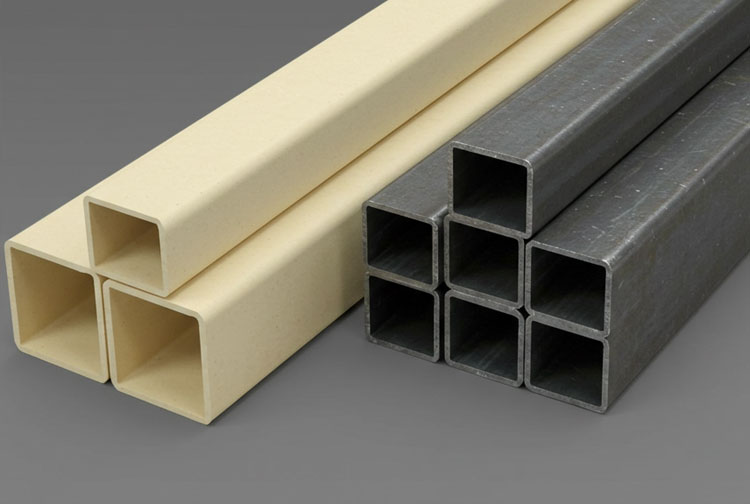
FRP Profiles vs Steel
Why FRP Profiles Outperform Steel: A Comprehensive Guide
Fiberglass Reinforced Polymer (FRP) profiles are revolutionizing industries traditionally dominated by steel. From construction to chemical processing, FRP is increasingly preferred for its unique properties. In this article, we explore the top 10 advantages of FRP profiles over steel, backed by real-world applications and technical insights.
1. Superior Corrosion Resistance
Keyword: Corrosion-resistant materials
Steel’s Achilles’ heel is its vulnerability to rust and corrosion, especially in harsh environments like coastal areas, chemical plants, or wastewater treatment facilities. FRP profiles, on the other hand, are inherently immune to corrosion. Made from a composite of polymer resin and glass fibers, FRP resists:
-
Saltwater exposure
-
Acidic/alkaline chemicals
-
UV radiation
-
Moisture
Example: In offshore oil platforms, steel structures require frequent anti-corrosion coatings, while FRP grating lasts decades without degradation.
2. Lightweight Yet Strong
Keyword: Lightweight structural materials
FRP profiles weigh 70-80% less than steel, simplifying transportation and installation. Despite their lightweight nature, FRP offers high strength-to-weight ratios:
-
Tensile strength comparable to steel
-
High impact resistance
-
No compromise on load-bearing capacity
Use Case: FRP bridges in remote areas are easier to assemble without heavy machinery, reducing project timelines and costs.
3. Lower Lifetime Costs
Keyword: FRP cost savings
While steel may have a lower upfront cost, FRP profiles save money over their lifecycle due to:
-
Zero maintenance: No need for painting, galvanizing, or rust removal.
-
Longer lifespan: FRP lasts 3–4 times longer than steel in corrosive environments.
-
Reduced downtime: Minimal repairs mean uninterrupted operations.
Stat: A 2022 study found that switching to FRP in chemical plants reduced maintenance costs by 60% over 10 years.
4. Design Flexibility
Keyword: FRP design flexibility
FRP can be molded into complex shapes, offering engineers unparalleled design freedom. Customizable features include:
-
Profiles (I-beams, channels, grating)
-
Surface textures (slip-resistant, smooth)
-
Colors (UV-stable pigments)
Steel, by contrast, requires welding or machining for customization, increasing labor and time.
5. Electrical and Thermal Insulation
Keyword: FRP durability
FRP is non-conductive, making it ideal for electrical applications like:
-
Utility poles
-
Cable trays
-
Transformer components
Steel’s conductivity poses risks of short circuits and requires additional insulation coatings.
6. Resistance to Fatigue and Creep
Keyword: Benefits of fiberglass reinforced polymer
Steel structures can weaken over time due to metal fatigue (repeated stress) and creep (deformation under load). FRP profiles excel in dynamic environments:
-
High fatigue resistance for vibrating machinery.
-
Minimal creep in high-temperature settings (up to 150°C).
Example: FRP rebar in concrete highways resists cracking caused by traffic load cycles.
7. Sustainability
Keyword: Sustainable construction materials
FRP is eco-friendly compared to steel:
-
Lower carbon footprint: Production emits 50% less CO₂.
-
Recyclable: FRP can be repurposed into new products.
-
Energy-efficient: Lightweight FRP reduces fuel consumption during transport.
Steel production, meanwhile, accounts for 7% of global CO₂ emissions.
8. Faster Installation
Keyword: Low maintenance FRP
FRP’s lightweight and modular designs enable rapid installation:
-
Pre-fabricated components snap into place.
-
No heavy lifting equipment needed.
-
Reduced labor costs.
Case Study: A water treatment plant replaced steel walkways with FRP grating, cutting installation time by 40%.
9. Fire Retardancy
Certain FRP formulations include fire-retardant additives, achieving:
-
Low flame spread ratings.
-
Self-extinguishing properties.
While steel doesn’t burn, it loses strength at high temperatures, risking structural collapse.
10. Adaptability to Extreme Environments
FRP performs reliably in temperatures ranging from -40°C to 120°C, whereas steel becomes brittle in freezing conditions and expands in heat.
Applications Showcasing FRP’s Advantages
-
Construction: FRP rebar in bridges, seawalls, and parking garages.
-
Chemical Industry: FRP tanks, pipes, and platforms resistant to acid spills.
-
Transportation: Lightweight FRP components in trains and aircraft.
-
Energy: FRP wind turbine blades and solar panel frames.
FRP vs Steel: Side-by-Side Comparison
| Factor | FRP Profiles | Steel |
|---|---|---|
| Corrosion | Immune | Prone to rust |
| Weight | 70–80% lighter | Heavy |
| Maintenance | None | High (coatings, repairs) |
| Lifespan | 30+ years | 10–15 years (in harsh environments) |
| Cost (Lifetime) | Lower | Higher |
Conclusion
FRP profiles outperform steel in almost every critical category—durability, cost-efficiency, safety, and sustainability. Industries transitioning to FRP are seeing reduced operational costs, enhanced safety, and longer asset lifespans. Whether you’re building a coastal facility or designing energy-efficient infrastructure, FRP is the material of the future.
Call to Action: Ready to explore FRP solutions? Contact our experts to find the right profile for your project!
 +86 15303735673
+86 15303735673 Jessica@frpzs.com
Jessica@frpzs.com
 Technical Data
Technical Data











